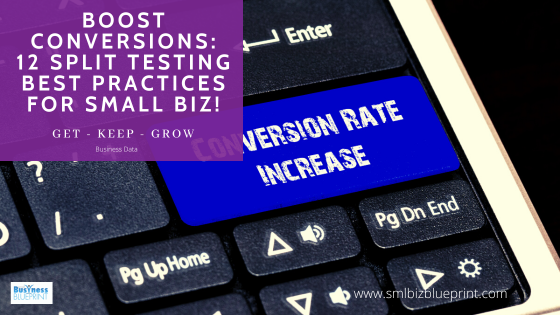In today’s competitive digital landscape, converting website visitors into customers is more challenging than ever. Every click, scroll, and interaction represents an opportunity for businesses to optimise their conversion rates and drive revenue growth.
One of the most powerful tools in a marketer’s arsenal is split testing, also known as A/B testing. This method allows for systematic experimentation to determine the most effective strategies for boosting conversions.
This guide will explore the top 12 split-testing strategies that can significantly impact your conversion goals. Each technique guides visitors through the conversion funnel, from crafting compelling headlines to optimising call-to-action buttons and leveraging social proof elements.
We’ll delve into the intricacies of implementing data-driven split tests, providing actionable insights and real-world examples to help you maximise your website’s potential for success.
Whether you’re a seasoned marketer looking to refine your conversion optimisation tactics or a newcomer eager to learn the ropes, this article will serve as your roadmap to unlocking the full potential of split testing.
Get ready to dive deep into conversion optimisation and discover how to transform your website into a conversion powerhouse.

#1 Crafting Compelling Headlines
When it comes to capturing the attention of your website visitors, the headline reigns supreme.
Attention is a scarce resource online, and your headline is the first impression you make on visitors.
A captivating headline should grab attention, evoke curiosity, and compel visitors to continue reading or take action.
Split testing allows you to experiment with different headline variations to identify which resonates most with your audience.
Consider testing elements such as tone, length, and emotional appeal to determine the optimal headline for maximising conversions.
Example:
Suppose you’re running an e-commerce website selling fitness products. You might split test headlines like “Transform Your Body with Our Revolutionary Fitness Gear” against “Achieve Your Fitness Goals Faster with Our High-Quality Equipment” to see which drives more conversions.
#2: Optimizing Call-to-Action Buttons
The call-to-action (CTA) button is the gateway to conversion on your website.
Every page on your website should feature a clear and compelling CTA button that guides visitors toward the desired action.
Factors like button colour, size, placement, and wording can significantly impact click-through and conversion rates.
Split testing allows you to experiment with different CTA button designs to determine which generates the highest conversion rate.
Consider testing variations in colour psychology, urgency language, and button size to identify the most persuasive CTA button for your audience.
Example:
For an online subscription service, you might split test CTA buttons with different wording, such as “Start Your Free Trial” versus “Unlock Exclusive Benefits Now,” to determine which drives more sign-ups.
#3: Leveraging Social Proof Elements
Consumers rely heavily on social proof to inform their purchasing decisions in today’s digital age.
Social proof elements, such as customer testimonials, reviews, endorsements, and trust badges, can significantly influence purchasing decisions by providing reassurance and validation.
Incorporating social proof strategically throughout your website can enhance trust and credibility, leading to higher conversion rates.
Split testing allows you to experiment with different types and placements of social proof elements to identify which resonates most with your audience.
Consider testing variations in the format, length, and placement of testimonials and reviews to determine the optimal strategy for maximising conversions.
Example:
For an e-commerce website selling skincare products, you might split test the placement of customer testimonials on product pages, comparing a sidebar carousel versus a dedicated section below the product description to see which drives more conversions.
#4: Perfecting Pricing Strategies
Pricing is a critical factor in the decision-making process for potential customers.
Pricing can significantly impact conversion rates, directly affecting perceived value and purchasing decisions.
When setting prices, it’s essential to balance competitiveness and profitability, considering market trends, competitor pricing, and customer perceptions.
Split testing allows you to experiment with different pricing strategies, such as discounts, bundling, and tiered pricing, to identify the optimal pricing model for your target audience.
Consider testing variations in pricing structures, such as offering a lower introductory price versus a higher price with added value, to determine which resonates best with your customers.
Example:
Suppose you’re running a software-as-a-service (SaaS) platform. You might split test pricing plans with different features and price points, such as a basic plan at $19.99 per month versus a premium plan at $29.99 per month, to see which generates more conversions and revenue.

#5: Enhancing User Experience with Page Style Optimization
Your website’s look and feel are crucial in shaping the overall user experience and influencing conversion rates.
A well-designed website instils trust and credibility in visitors, making them more likely to engage with your content and take action.
Factors such as layout, colour scheme, typography, and imagery all contribute to your website’s overall aesthetics and usability.
Split testing allows you to experiment with different page styles to identify which resonates most with your target audience and leads to higher conversion rates.
Consider testing variations in design elements, such as the placement of key elements, the use of whitespace, and the incorporation of visual cues, to optimise user experience and drive conversions.
Example:
For an e-commerce website selling fashion apparel, you might split test two page styles—one featuring vibrant colours and bold typography for a youthful audience and another with a minimalist design and elegant imagery for a more sophisticated audience—to see which yields higher conversion rates.
#6: Maximizing Engagement with Video Content
Video has become an increasingly popular and effective medium for engaging audiences and driving conversions.
Video content allows you to convey complex concepts, showcase product features, and evoke emotion in a way that static images and text alone cannot.
Incorporating videos throughout your website can increase engagement, time spent on a page, and overall conversion rates.
Split testing allows you to experiment with different video styles, lengths, and placements to identify which resonates most with your audience and drives the highest conversion rates.
Consider testing variations in video content, such as product demonstrations, customer testimonials, and brand storytelling, to determine the most effective approach for engaging your target audience and driving conversions.
Example:
For a travel booking website, you might split test two different video styles—one featuring breathtaking destination footage and adventurous activities, and another focusing on customer testimonials and travel experiences—to see which drives higher engagement and conversion rates.
#7: Harnessing the Power of Urgency and Scarcity
Creating a sense of urgency and scarcity can be powerful motivators for driving conversions and increasing sales.
Urgency and scarcity compel customers to take action quickly out of fear of missing out on a limited-time offer or product availability.
Tactics such as limited-time discounts, countdown timers, and low-stock alerts can create a sense of urgency and scarcity that motivates customers to purchase.
Split testing allows you to experiment with different urgency and scarcity tactics to identify which resonates most with your audience and drives the highest conversion rates.
Consider testing variations in messaging, timing, and visuals to optimise the effectiveness of urgency and scarcity in your conversion optimisation strategy.
Example:
For an e-commerce website, you might split test two different urgency tactics—one featuring a countdown timer for a limited-time sale and another highlighting low stock availability for a popular product—to see which drives higher conversion rates.
#8: Maximizing Revenue with Back-end Offers and Upsells
Generating additional revenue from existing customers is a crucial strategy for maximising profitability and increasing the lifetime value of your customer base.
Back-end offers and upsells present opportunities to upsell customers on complementary products or premium upgrades after purchasing.
By strategically presenting relevant offers during checkout, you can increase the average order value and generate additional revenue with minimal effort.
Split testing allows you to experiment with different back-end offers and upsell strategies to identify which resonates most with your customers and drives the highest conversion rates.
Consider testing variations in offer placement, pricing, and messaging to optimise the effectiveness of back-end offers and upsells in your conversion optimisation strategy.
Example:
For a subscription-based software service, you might split test two different upsell offers—one offering a premium feature upgrade at a discounted rate and another promoting a bundle package with additional benefits—to see which drives higher revenue per customer.

#9: Personalizing the User Experience with Custom Landing Pages
Tailoring your landing pages to specific audience segments can significantly improve relevance and conversion rates.
Every traffic source is unique, and custom landing pages allow you to tailor your messaging and offers to specific audience segments.
You can increase relevance and engagement by matching your landing pages’ content and messaging to your visitors’ intent and interests, leading to higher conversion rates.
Split testing allows you to experiment with different landing page variations for different traffic sources to identify which drives the highest conversion rates.
Consider testing variations in headline copy, imagery, and offers to optimise the effectiveness of your custom landing pages in converting visitors into customers.
Example:
For an e-commerce website, you might split test two landing pages—one targeting visitors from social media with lifestyle imagery and social proof elements and another targeting visitors from search engines with product-focused copy and reviews—to see which yields higher conversion rates.
#10: Capturing Abandoning Visitors with Exit Pop-Ups
Exit pop-ups offer a second chance to capture the attention of visitors who are about to leave your website.
Exit pop-ups can provide last-minute incentives, discounts, or offers to persuade visitors to reconsider leaving and take action before exiting your website.
Exit pop-ups can effectively reduce bounce rates and increase conversions by addressing objections or offering additional value at the moment of abandonment.
Split testing allows you to experiment with different exit pop-up designs, offers, and timing to identify which resonates most with your audience and drives the highest conversion rates.
Consider testing variations in messaging, incentives, and call-to-action buttons to optimize the effectiveness of your exit pop-ups in capturing abandoning visitors.
Example:
For an e-commerce website, you might split test two exit pop-up offers—one offering a discount code for first-time customers and another promoting a limited-time free shipping offer—to see which encourages more visitors to stay and complete their purchase.
#11: Providing Real-Time Support with Chat Support
Live chat support offers a convenient way for visitors to get immediate assistance and answers to their questions.
Live chat support allows you to address visitor inquiries, provide product recommendations, and overcome objections in real time, leading to higher conversion rates.
Live chat can increase trust, engagement, and satisfaction by offering personalised assistance and support throughout the customer journey, ultimately driving more conversions.
Split testing allows you to experiment with different chat support strategies, such as proactive chat invitations, response times, and agent training, to identify which drive the highest conversion rates.
Consider testing variations in chat widget placement, messaging, and design to optimise the effectiveness of your live chat support in converting visitors into customers.
Example:
For an e-commerce website, you might split test two chat support strategies—one offering proactive chat invitations on product pages and another prominently displaying a chat widget on the checkout page—to see which leads to more conversions and sales.
#12: Building Trust with Phone Support
Phone support offers a personal and reassuring touch that can help build trust and credibility with potential customers.
Phone support provides customers with a direct line of communication with your business, allowing them to get immediate assistance and answers to their questions.
By offering phone support, you can reassure customers that help is readily available. This will increase trust and confidence in your brand, leading to higher conversion rates.
Split testing allows you to experiment with different phone support strategies, such as toll-free numbers, call-back requests, and business hours, to identify which resonates most with your audience and drives the highest conversion rates.
Consider testing variations in call-to-action messaging, phone number placement, and availability to optimise the effectiveness of your phone support in converting visitors into customers.
Example:
For a B2B service provider, you might split test two phone support strategies—one offering a toll-free number with extended business hours and another allowing visitors to schedule a callback at their convenience—to see which leads to more conversions and sales.
In conclusion, mastering conversion optimisation through split testing is a continuous journey that requires experimentation, analysis, and adaptation.
Throughout this guide, we’ve explored the top 12 strategies for optimising conversions, from crafting compelling headlines to leveraging social proof elements and harnessing the power of urgency and scarcity to providing real-time support with live chat and phone assistance.
By implementing these strategies and leveraging the power of split testing, you can unlock your website’s full potential and drive higher conversion rates, ultimately leading to increased revenue and business growth.
Remember, there is no one-size-fits-all solution, and success lies in understanding your audience, testing different approaches, and iterating based on the data and insights you gather along the way.
As you embark on your conversion optimisation journey, we encourage you to start small, test often, and continuously refine your strategies based on what works best for your audience.
Whether you’re a seasoned marketer or a newcomer to conversion optimisation, the key is to stay curious and data-driven and strive for improvement.
Are you ready to improve your conversion optimisation efforts? Implement these strategies today and see their impact on your website’s performance.




